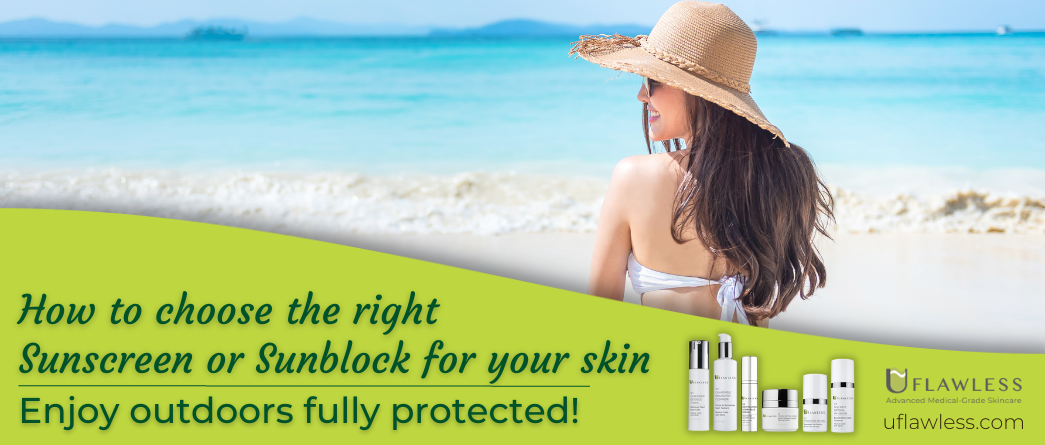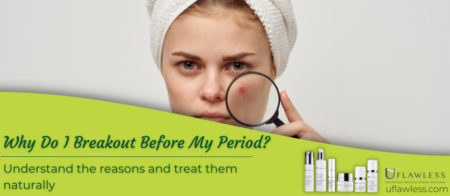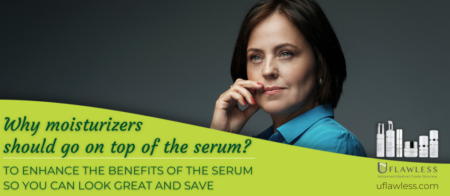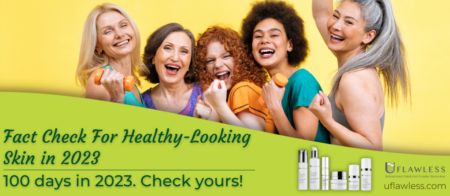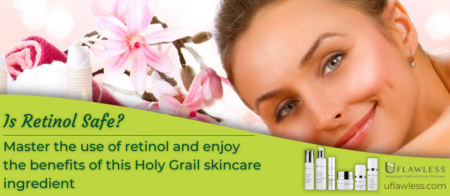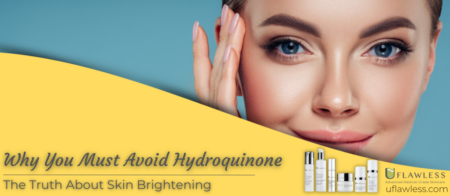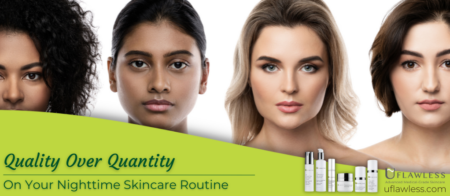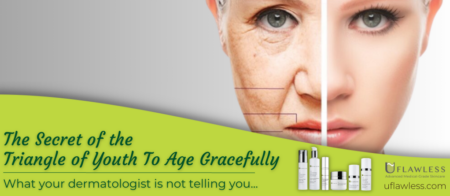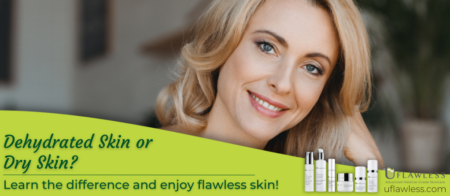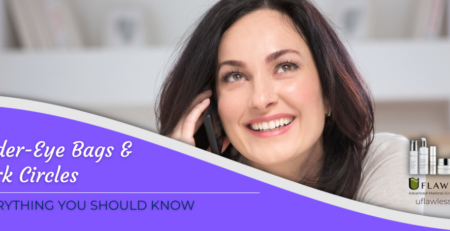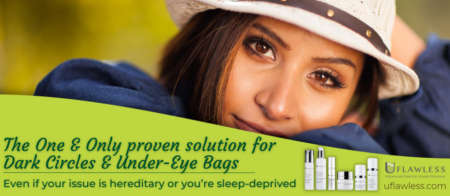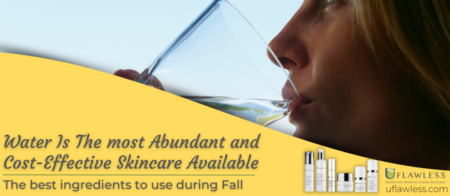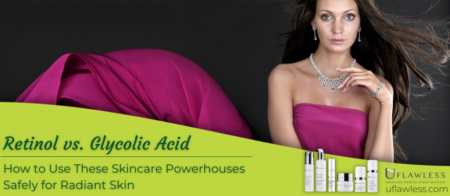How to Choose the Right Sunscreen or Sunblock For My Skin?
To choose the right sunscreen or sunblock for your skin is crucial for maintaining healthy skin and protecting it from the sun’s harmful rays.
In this guide, we’ll explore the differences between sunscreen and sunblock.
We’ll discuss key factors to consider when selecting sun protection and provide helpful tips to ensure you make the best choice for your skin type and lifestyle.
With the correct information and guidance, you’ll be well-equipped to make an informed decision and enjoy the benefits when you choose the right sunscreen or sunblock for your skin.

What’s the Difference Between Sunscreen and Sunblock? And Choose the Right Sunscreen Or Sunblok for your Skin.
Sunscreen and sunblock both provide protection from the sun’s harmful rays, but they work differently.
Sunscreen absorbs the sun’s ultraviolet (UV) radiation, while sunblock physically reflects it.
Sunscreen contains organic (chemical) ingredients, while sunblock uses inorganic (physical) ingredients such as zinc oxide and titanium dioxide.
Let’s see below, what are the pros and cons of each other, so you can choose the best sunscreen or sunblock for your skin.
Pros and Cons Of Sunscreen and Sunblock, And Choose The Right Sunscreen or Sunblock for Your Skin.
Pros
Sunscreen
Sunblock
- Protection
- Texture
- Application
- Broad Spectrum
- Skin Compatibility
- Absorbs UVA/UVB rays
- Lightweight, less visible on skin
- Easy to apply, various formulations
- Can offer UVA/UVB protection
- Suitable for most skin types
- Reflects UV rays
- Thicker, more visible on skin
- Immediate protection, more water resistant
- Can offer UVA/UVB protection
- Less likely to cause irritation/allergies
Cons
Sunscreen
Sunblock
- Skin Irritation
- Reapplication
- Environmental
- Stability
- Appearance
- May cause irritation or allergies
- Requires application every 2 hours
- Some chemicals harmful to marine life
- Can break down over time, less effective
- Easier to blend into skin
- Less likely to cause irritation/allergies
- May require more frequent reapplication
- Generally safer for marine life
- More resistant to water and sweat
- Can leave a white or chalky residue
Keep in mind that the choice between sunscreen and sunblock depends on individual preferences, skin type, and specific needs.
It’s essential to test different products and formulations to find the one that works best for you and provides adequate sun protection.
Why Should We Protect the Skin from the Sun?
Protecting the skin from the sun is crucial for several reasons:
- Prevent Skin Cancer: Prolonged exposure to the sun’s ultraviolet (UV) radiation can lead to skin cancers, including melanoma which is the most dangerous type.
- Avoid Premature Aging: The sun’s UV rays can accelerate the aging process of the skin, causing premature wrinkles, fine lines, and age spots.
- Prevent Sunburn: Sunburn is not only painful but also damages the skin cells and blood vessels, which can increase the risk of skin cancer over time.
- Protect against Photosensitivity: Certain medications and conditions can make your skin more sensitive to sunlight, leading to rashes, redness, or other reactions.
- Preserve Skin Health: UV radiation can damage the texture and quality of the skin, leading to sagging, rough patches, and loss of elasticity.
- Prevent Eye Damage: Exposure to UV radiation increases the risk of certain types of eye conditions, such as cataracts and macular degeneration.
- Protect from Infrared and HEV Light: Beyond UV rays, the sun also emits infrared and High Energy Visible (HEV) light that can lead to skin damage and premature aging.
Therefore, using a comprehensive sunscreen, not only protects from UVA and UVB rays, but also from HEV light, infrared light, and pollution, is an essential part of maintaining healthy skin.
The 4 Steps on How to Choose The Right Sunscreen or Sunblock For Your Skin
Step 1 – Broad Spectrum:
Choose a product that offers broad-spectrum protection, which means it protects against both UVA and UVB rays.
Next Generation Sunscreens protect you from UVA, UVB, and HEV (Blue Light) from TVs, computer screens, tablets, cellphones, and fluorescent lights.
Step 2 – SPF (Solar Protection Factor) In Sunscreen and Sunblock:
Select a sunscreen with an SPF of at least 30 for adequate protection.
Step 3 – Ingredients In Sunscreen and Sunblock:
Look for a product according to your lifestyle to ensure the best protection.
Mother Nature should play an important role in this decision-making process:
Chemical Sunscreens may be environmentally damaging, especially the ones carrying Oxybenzone and Octinoxate, Benzophenone-1, Benzophenone-8, OD-PABA, 4-Methylbenzylidene camphor, 3-Benzylidene camphor, and Octocrylene.
These can affect corals’ reproductive cycle, damage DNA, and worsen the effects of coral bleaching.
Step 4 – Formulation in Sunscreen and Sunblock:
Consider your skin type and preferences when choosing sunscreen or sunblock.
For example, those with sensitive skin may prefer a sunblock with physical ingredients,.
What Does the SPF Number Mean?
The Sun Protection Factor (SPF) number is a crucial aspect of any sunscreen product.
It indicates the level of protection the sunscreen offers against harmful UVB rays, which cause sunburns and contribute to skin cancer.
The SPF number essentially tells you how much longer it would take for your skin to redden under the sun when using the product as directed, compared to the time it would take without any sunscreen.
For example, with SPF 30, it would take you 30 times longer to burn than if you weren’t wearing sunscreen.
An SPF 30 allows about 3% of UVB rays to reach your skin, while SPF 50 allows only 2% through.
Though this may seem like a small difference, SPF 30 permits 50% more UV radiation on your skin than SPF 50.
More than just SPF as a Number, Full Broad Spectrum is the Best Choice
Full broad-spectrum protection, which includes protection against UVA, UVB, HEV (blue) light, and infrared light. This can help you with more information
Offers a more comprehensive shield for your skin compared to traditional broad-spectrum protection that only covers UVA and UVB rays.
Here’s why full broad-spectrum protection is important To choose the Right Sunblock or Sunscreen:
Full Broad-Spectrum means that the sunblock covers more than just UVA/UVB.
Protects you against HEV Light (Blue Light) and Infra-Red Light
- UVA and UVB rays: While UVA and UVB rays are the most well-known types of solar radiation that cause skin damage, they are not the only sources. UVA rays penetrate deep into the skin, causing premature aging and wrinkles, while UVB rays cause sunburn and are the primary cause of skin cancer. Broad-spectrum sunscreens protect against both types of rays, essential for overall skin health.
- HEV (blue) light: High-energy visible (HEV) light, also known as blue light, is emitted by electronic devices such as smartphones, tablets, computer screens, and LED lights. Prolonged exposure to HEV light can lead to skin damage, such as premature aging, inflammation, and hyperpigmentation. Full broad-spectrum sunscreens include protection against HEV light, which is increasingly important in our technology-driven world.
- Infrared light: Infrared light makes up about 54% of the solar radiation reaching the Earth’s surface. It penetrates deeper into the skin than UVA and UVB rays leading to the breakdown of collagen and elastin, resulting in sagging skin and wrinkles. Full broad-spectrum sunscreens that protect against infrared light help preserve your skin’s structural integrity and youthful appearance.
Protect Yourself from Solar Radiation and Modern Lifestyle Factors
By providing protection against all these sources of skin damage, full broad-spectrum sunscreens offer a complete defense against the harmful effects of solar radiation and modern lifestyle factors.
Modern lifestyle factors such as being in the sun for a walk or going to work, and also being inside of an office with fluorescent lights, in front of computer screens, tablets, and cell phone screens.
This comprehensive protection is essential to maintaining healthy, youthful skin and reducing the risk of skin cancer, hyperpigmentation, and premature aging.

Who should have extra care with their skin?
Individuals with a history or high risk of skin cancer, genetic diseases like albinism or xeroderma pigmentosum, or certain immune disorders might find that SPF 50 isn’t enough protection.
The same applies to specific situations, such as hiking or skiing at high altitudes or vacationing near the equator.
The Skin Cancer Foundation recommends using a water-resistant, broad-spectrum sunscreen with an SPF of 30 or higher for extended outdoor activities.
Regardless of the SPF, it’s essential to apply one ounce (two tablespoons) of sunscreen 30 minutes before going outside and reapply it every two hours, or immediately after swimming or sweating, to ensure adequate sun protection.
Sunscreen Ingredients
Sunscreen ingredients can be broadly divided into two categories:
Organic (chemical) and Inorganic (physical or mineral).
Organic compounds in sunscreen are chemicals that absorb harmful UV rays, converting them into heat, which is then released from the skin.
Here are more details about some common organic sunscreen ingredients:
- Avobenzone: Avobenzone is a commonly used organic compound in sunscreen formulations. It is known for its ability to absorb a wide range of UV rays, particularly UVA I rays which can deeply penetrate the skin and cause premature skin aging and wrinkles. However, avobenzone can be unstable when exposed to sunlight, often requiring the presence of other ingredients such as octocrylene to stabilize it.
- Oxybenzone: Oxybenzone is another widespread ingredient in sunscreens due to its ability to absorb both UVA and UVB rays, offering broad-spectrum protection. However, oxybenzone is controversial due to concerns about potential hormonal disruption and its impact on marine ecosystems. Some regions, such as Hawaii, have banned sunscreens containing oxybenzone to protect coral reefs.
- Octinoxate: Octinoxate (or Octyl Methoxycinnamate) is used in sunscreens for its effectiveness in absorbing UVB rays, the primary cause of sunburn and a significant factor in skin cancer. It helps protect the skin from the harmful effects of exposure to sunlight. However, similar to oxybenzone, octinoxate has been associated with environmental concerns, particularly coral bleaching, leading to bans in some places.
When choosing a sunscreen, it’s important to consider not only its ability to protect against UV radiation but also its impact on your overall health and the environment.
Also, as with any skincare product, individuals may react differently to different ingredients, so it’s crucial to find a sunscreen that suits your skin type and needs.
Sunblock Ingredients
Sunblock ingredients are typically inorganic compounds, also known as physical or mineral blockers.
These ingredients work differently from the organic compounds found in sunscreens.
Instead of absorbing UV radiation, they physically block it, reflecting the rays off the skin’s surface.
Here’s a deeper dive into the common sunblock ingredients:
- Zinc Oxide: A naturally occurring mineral, Zinc Oxide is a popular ingredient in sunblock due to its ability to provide broad-spectrum protection, blocking both UVA and UVB rays. Zinc Oxide sits on the skin’s surface and scatters and reflects the sun’s harmful rays. It is also known for its soothing properties and is often used in products designed for sensitive or irritated skin. One of the downsides of Zinc Oxide in the past was the white residue it left on the skin, but newer formulations have minimized this effect with the use of “nano” particles.
- Titanium Dioxide: Another naturally occurring mineral, Titanium Dioxide works similarly to Zinc Oxide by reflecting and scattering UV radiation. It is particularly effective against UVB rays. Titanium Dioxide is also a common ingredient in sunblocks designed for sensitive skin as it is less likely to cause skin irritation. Like Zinc Oxide, it has been traditionally associated with a white cast on the skin, but newer formulations have improved its aesthetics.
Both Zinc Oxide and Titanium Dioxide are considered safe for use on the skin and have a lower likelihood of causing skin reactions compared to some organic sunscreen ingredients.
They are also less harmful to marine life, making them a good choice for those seeking reef-safe sun protection options.
However, as with all skincare products, individual skin types and sensitivities may react differently, and it’s always crucial to find a product that suits your specific needs.
The Best Ingredients on Sunscreen and Sunblock for Acne
For individuals with acne-prone skin, zinc oxide is often considered the better option. Here’s why:
- Zinc Oxide: This ingredient is known for its soothing properties and is often used in products designed for sensitive or irritated skin. Zinc oxide is anti-inflammatory, and it can provide a calming effect on acne skin. It also does not clog pores, making it a good choice for people who are prone to acne breakouts.
- Titanium Dioxide: While this ingredient is also less likely to cause skin irritation, it doesn’t have the same anti-inflammatory properties as zinc oxide. Therefore, it may not provide the same level of benefit to acne-prone skin.
Both ingredients are considered non-comedogenic, meaning they shouldn’t clog pores or contribute to acne.
However, it’s important to note that everyone’s skin is different, and what works best can vary from person to person.
It’s always a good idea to patch-test new products and consult with a dermatologist if you’re unsure.
Does Sunscreen Give More Protection Than Sunblock? Learn How to Choose the Right Sunscreen or Sunblock
Both sunscreen and sunblock can provide adequate sun protection if used correctly.
The choice between them often comes down to personal preference and skin type.
When discussing the level of protection offered by sunscreen and sunblock, it’s crucial to understand the difference between them and the mechanisms through which they work.
Sunscreen is a chemical defense against the sun, absorbing harmful UV radiation before it can damage the skin.
Its organic compounds convert UV rays into heat, which is then released from the skin.
Sunscreen is often more comfortable and less noticeable on the skin, as it tends to be lighter and less greasy.
It’s also available in a wider range of SPFs, giving you more control over the level of protection.
However, sunscreen’s chemical ingredients can sometimes cause skin irritation or allergic reactions, especially in sensitive individuals.
Importantly, certain chemical UV filters, such as oxybenzone and octinoxate, have been found to harm coral reefs and marine life, leading some places to ban sunscreens containing these ingredients.
Sunblock, on the other hand, is a physical defense that sits on top of the skin and reflects or scatters UV radiation away.
Containing inorganic compounds like zinc oxide and titanium dioxide, sunblock provides a literal barrier between your skin and the sun.
It’s often thicker and may leave a white cast, but it’s less likely to cause skin irritation, making it a good choice for sensitive or acne-prone skin.
Because it physically blocks UV rays, sunblock provides broad-spectrum protection against both UVA and UVB rays.
Additionally, sunblocks that use non-nano zinc oxide and titanium dioxide are considered to be more environmentally friendly as these particles are too large to be ingested by coral reefs.
Is It Okay to Use Sunscreen or Sunblock Every Day?
Yes, it is not only okay but also highly recommended to use sunscreen or sunblock every day, regardless of the weather or season. This is due to several reasons:
- Consistent UV Exposure: The sun emits harmful UV rays all year round, not just during summer or on sunny days. Even on cloudy days, up to 80% of the sun’s harmful UV rays can penetrate your skin.
- Indoor Exposure: UV rays can penetrate windows, so you’re exposed even when you’re indoors. Furthermore, HEV light (also known as blue light) from electronic devices can also contribute to skin damage and premature aging.
- Cumulative Damage: Damage from the sun is cumulative, which means it builds up over time from repeated exposure.
- Prevent Skin Aging and Cancer: Daily application of sunscreen can help prevent premature skin aging (like wrinkles and sun spots) and lower the risk of skin cancer.
- Protection from Other Elements: Next-generation sunscreens, like the X3 Primer Moisturizing SPF 40, offer protection not just against UVA and UVB rays, but also against HEV light, infrared light, and pollution, offering more comprehensive skin defense.
Remember to apply a broad-spectrum sunscreen with an SPF of at least 30 to all exposed skin, and reapply every two hours, or after swimming or sweating.
It’s also important to note that while daily sunscreen use is crucial, it’s not a stand-alone solution.
It should be combined with other sun-protection measures like seeking shade during peak sunlight hours, wearing protective clothing, and wearing sunglasses.
Does Sunscreen Really Prevent Wrinkles?
Sunscreen can help prevent wrinkles by protecting your skin from the sun’s harmful UV rays, which cause premature aging.
By blocking these rays, sunscreen can help maintain your skin’s youthful appearance.
Introducing the X3 Primer Moisturizing SPF 40: The Ultimate Sunblock for Wrinkle Prevention
The X3 Primer Moisturizing SPF 40 is a next-generation sunscreen, or better said, sunblock, that not only protects against UVA and UVB rays but also offers protection from HEV (blue) light, infrared light, and pollution.
This broad-spectrum protection helps prevent the formation of wrinkles and other signs of premature aging.
The X3 Primer Moisturizing SPF 40 contains potent antioxidants and other ingredients that work together to maintain your skin’s radiance and youthful appearance.
By incorporating this sunscreen into your daily routine, you can enjoy comprehensive sun protection and keep your skin looking its best.
Complete Skin Defense: Beyond Just Sunscreen
The question shouldn’t just be, “What sunscreen should I use?” but rather, “What is the best strategy for maximum skin protection?”
In order to choose the right sunscreen or sunblock, you should check: A high-SPF (at least 30), broad-spectrum formulation or a next-generation one that shields against UVA, UVB, HEV light, infrared light, and pollution, plays a pivotal role in skin defense.
However, Sunscreen it’s not a standalone solution.
In truth, no single method of sun defense is foolproof.
The sun’s harmful effects aren’t limited to just the time spent sunbathing on a beach; they accumulate over daily activities like walking the dog, driving, or sitting by a window.
This necessitates a multi-faceted approach to protect your skin.
Sunscreen should be one essential component of a holistic skin protection strategy that includes multiple lines of defense.
This strategy should also incorporate physical barriers such as clothing, wide-brimmed hats, and UV-blocking sunglasses.
Such barriers can physically block a significant amount of UV radiation from reaching your skin.
Additionally, seeking shade, especially during the sun’s peak intensity hours, between 10 a.m. and 2 p.m., is a simple yet effective way to limit your UV exposure.
However, remember that shade structures like umbrellas or trees can only filter out a portion of the sun’s UV radiation.
Supplementing these protective measures with a healthy lifestyle that includes a balanced diet rich in antioxidants, regular exercise, and adequate hydration can also help maintain your skin’s health and resilience against UV damage.
Ultimately, the best strategy for skin protection is a complete one.
It’s about considering all risk factors, understanding that every bit of protection counts, and making sun safety a part of your daily routine.
Only then we can effectively safeguard our skin from the harmful effects of the sun and other environmental aggressors.
Scientific References on How to Choose The Best Sunscreen or Sunblock for My Skin
Skin Cancer Foundation – Understanding Sun Protection Factor: https://www.skincancer.org/skin-cancer-prevention/sun-protection/sunscreen/#:~:text=The%20SPF%20number%20tells%20you,damage%20than%20lower%20SPF%20products.
American Cancer Society: https://www.cancer.org/cancer/latest-news/choose-the-right-sunscreen


